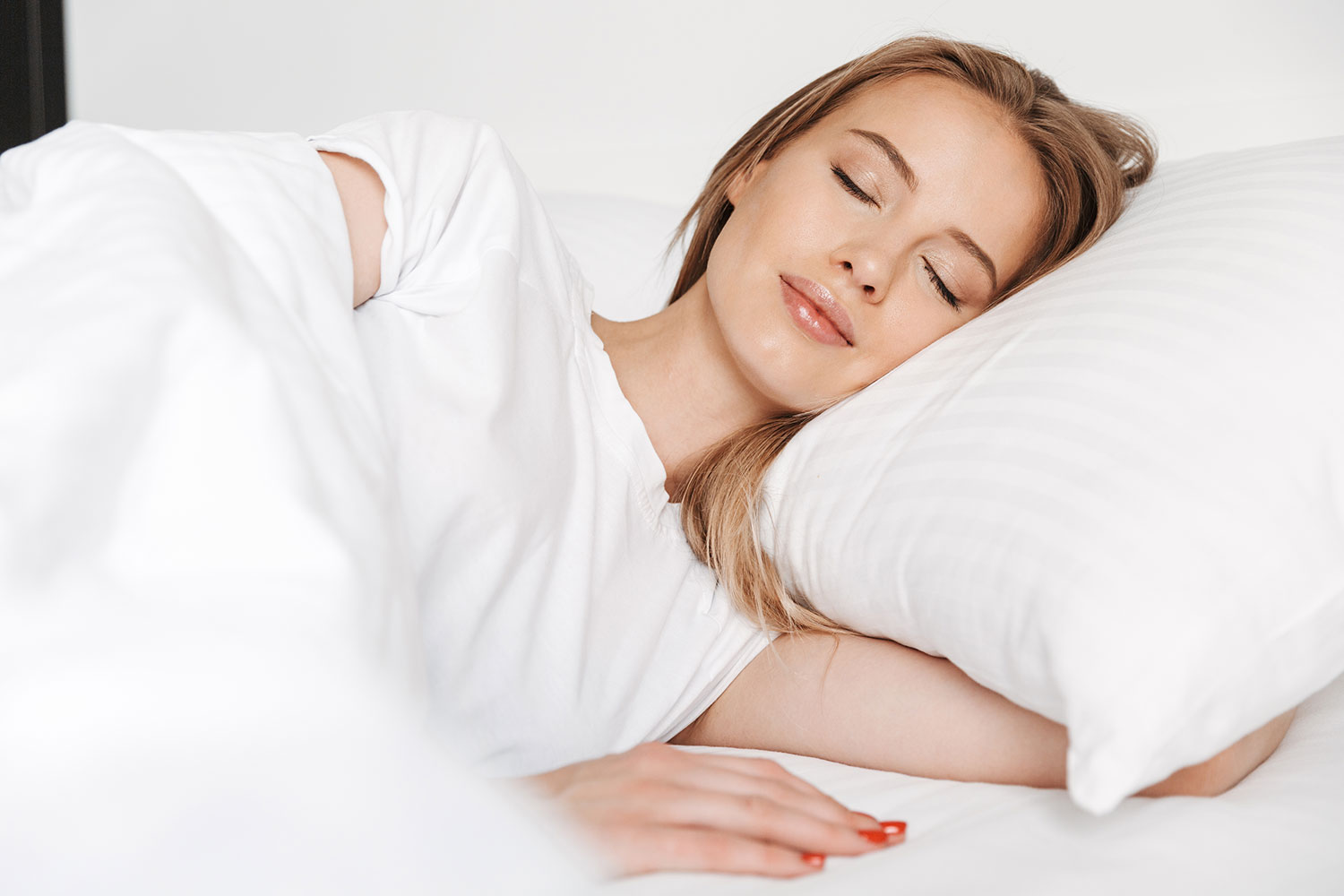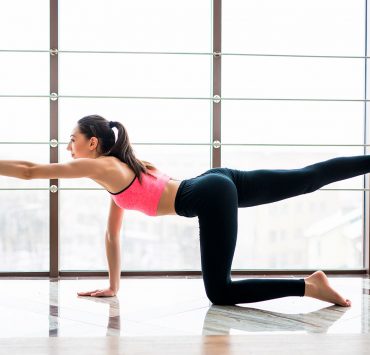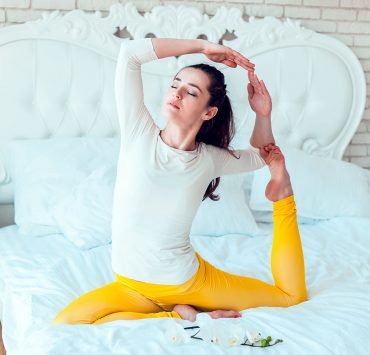
Having been a teacher’s assistant at over 50 yoga teacher…
Yoga asanas can help you let go of the stress of the day and ease into peaceful sleep. You’ll find that a daily yoga practice can increase the deep sleep that you experience, and even have better dreams. Imagine waking up feeling refreshed and rejuvenated. A nightly yoga ritual, or even one at night or in the afternoon, has so many health benefits. One that many yogis notice is a better night’s sleep.
Simple, gentle poses can do a lot in the process of getting ready for bed. Yoga postures are a traditional remedy to getting rid of insomnia and to ease you into a better slumber.
Performing these beginning yoga poses can benefit your total sleep cycle. Fall asleep faster, stay asleep longer, don’t wake up in the middle of the night, and wake up in the morning feeling like you got a good night’s rest.
Over time, performing these easy yoga sequences can help you to regulate your breathing, balance your body’s systems and to lessen the stress. Move tension out of your muscles and body and find that you can sleep much better at night. It can help to bring quiet to your mind, simplify your thoughts and let you sleep like a baby.
The sleep effects of yoga are well documented. In one survey, 55% of yogis experienced better sleep. Another 85% of them said that yoga helps with stress.
This sequence is modified from BKS Iyengar’s recommendations for insomnia. These poses are all simple and easy to perform. Just because they’re easy, doesn’t meant that they aren’t efficient. Regular practice and devotion to the practice will yield the best benefits. Many of these poses help to ease the effect of the heart and allow the body system to relax. These poses also help to promote restfulness and a grounding effect into the body. Simply easing the burdens of the mind and allowing healthy, regular breathing does a lot in promoting a restful night’s sleep.
Once the sleep problems are under control, you can perform this series 1 or 2 times a week and still have good sleep. There are also more advanced poses recommended for insomnia, like headstand, shoulderstand or plough, but these are not as beginner friendly. Still, as you advance in your yoga practice, you might want to explore these more advanced poses as they have other benefits that you can experience in your life.
For better sleep, try to follow a yogic lifestyle. Drink plenty of water as this heals the body’s systems and will make breathing easier. Try to drink less caffeine and replace your morning coffee with an herbal tea or juice. Proper nutrition and making sure to not take too much sodium will also help with sleep problems.
Insomnia is more than just a physical problem. It also is a physical, mental, and spiritual one. Yoga can help you to address these concerns with gentle remedies and better breathing. Many doctors say that lack of physical activity can be attributed to the cause of insomnia as well as too much exposure to screens. Yoga helps with both, and it could be the cure you’re looking for. It is cost effective and has a lot more benefits like improving your mood, helping your posture, whole body healing, and so much more! Here are some simple poses to help you fall asleep soundly and faster at your bedtime.
Uttanasana — Standing Forward Fold Pose

From a standing position on the mat, bend over and try to touch your hands to the floor. Bring your head to your knees if you can. You can also hug your legs. Try to keep your legs as straight as you can. It’s okay to bend them in the beginning, or you can use blocks if you can’t reach the ground. Another variation of this is to touch your toes. It provides a rush of rejuvenating blood to the head and to give the heart a break from constantly pumping blood up to the brain.
Prasarita Padottanasana — Wide-Legged Forward Bend Pose

After holding uttanasana, stretch your legs a little further than shoulder length apart. You can lean all the way forward and try to put y your head on the ground, or simply put your hands on the floor. You should be able to reach the ground, but if you can’t you can use a block to make it easier. This is a grounding sequence that encourages a relaxing stretch in the inner thighs and legs, and furthers the benefits from the standing forward bend. Bringing blood flow to the head in this position eases the stress on the heart and can ease the process of sleep.
Adho Mukha Svanasana — Downward Facing Dog Pose

Downward facing dog is a staple in many yoga practices. It has many health benefits, and one of them is that it can ease the burden of insomnia. It is easy to transition to downward facing dog from wide legged standing forward bend. The practice stretch might make it easier to reach your heels to the ground if this is something that you still have yet to master. Downward facing dog represents letting go and surrendering. Dogs love to nap and maybe channeling your inner canine can be your key to inner peace.
Salamba Balanasana — Child’s Pose

The rest of these poses can be performed in bed. Child pose will give you relief from the intense stretch of the inverted postures. It is also one of the easiest poses. When transitioning into child’s pose, make sure to take deep and even breaths. Stretch out the length of your spine and relax into the posture. It is a sweet and simple move that will help you have sweet dreams.
Supta Baddha Konasana — Reclined Cobbler’s Pose

This is another seated pose that gives a relaxing stretch and helps to Your lover back and inner legs, which often hold a lot of tension, are relaxed in this pose. You can either start in butterfly pose and lay back, or lay down and then bring the soles of the feet together. Modify this pose with a blanket if you feel resistance or tension. It helps the circulatory system, enhances the mood, stimulates the abdominal muscles and stretches the groin and inner thighs.
Paschimottanasana — Seated Forward Fold Pose

By this time in the sequence, you should feel a bit more relaxed. Sit forward in staff pose, and then lean and grab for your toes. This pose helps to encourage sleep by moving stored up energy and relieving tension in the spinal column. It prepares your body for a restful night’s sleep by easing built up stress in the lower part of the body that is otherwise unaddressed by methods other than yoga asana. You should be able to reach your toes. If you can’t, then use a scarf to tie around your feet and lean your head forward to the knee.Hold this pose for five deep breaths, or as long as you feel like.
Supta Virasana — Reclined Hero’s Pose

This pose is counter indicated if you have knee problems. Some of the benefits of this pose are better breathing and stress reduction. It can help to clear the arteries and to promote a strong heart. It is also a good pose for lower back strength. It’s a good pose to treat inflammation in the knees, and relieves pain in the legs and feet. It’s a resting pose for the legs, so if you are on your feet all day, it is a good pose to give relief to the lower half of your body. Reclined Hero’s Pose can also ease indigestion.
Setu Bandha Sarvangasana — Bridge Pose

This pose is another one that you can perform in your bed, before you go to sleep or when you wake up. It tones the pelvic and abdominal region, and helps with nervous tension. Bridge pose is a very easy pose to perform, and it helps you to develop strength in the lower part of your body, including glutes.
Viparita Karani — Legs Up The Wall Pose

This is a fundamental yin yoga pose that helps to release all of the stresses of the day and prepare you for sleep. Legs up the wall can be performed in bed if you have a headboard or access to the wall. It gently strengthens your neck, arms and back
Swastikasana — Easy cross legged pose

The Japanese name for this position is zazen. It has been medically shown in brain wave studies that holding this position for 15 minutes a day with regulated breathing results in more alpha brainwaves in the body. It is also known as the Auspicious Pose. This is a simple pose that you can meditate in and have plenty of benefits.
Savasana — Сorpse pose

Some yoga practicers claim to doze off in this pose. It is a deeply relaxing and restorative pose that encourages you to look within and surrender. If you’re performign this series in bed, you can ease off into sleep after performing this pose.
There are many gentle, easy poses to do that help to restore well-being and for you to relax and rejuvenate before bed. This series is meant to promote good night’s sleep and ease the symptoms of insomnia. Adjust the length you hold the poses to your skill level. You should be able to see benefits in about a week.
What's Your Reaction?
Having been a teacher’s assistant at over 50 yoga teacher trainings worldwide, Rebecca Rebecca has a firm grasp on the fine art of yoga and meditation. In her work, she carefully reflects on a vast expanse of knowledge to help others find peace in both body and mind.














